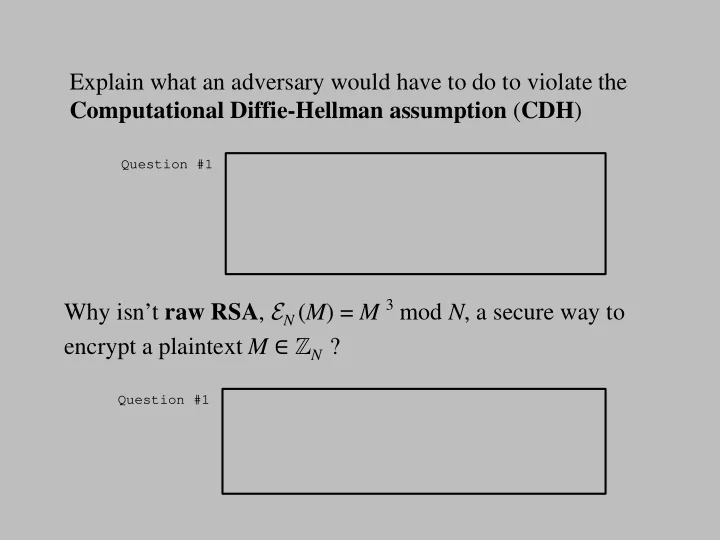

Explain what an adversary would have to do to violate the Computational Diffie-Hellman assumption ( CDH ) Question #1 Why isn’t raw RSA , E N ( M ) = M 3 mod N , a secure way to encrypt a plaintext M ∈ ℤ N ? Question #1 1
Explain what an adversary would have to do to violate the Computational Diffie-Hellman assumption ( CDH ) Do well at computing g ab from g a and g b Question #1 (for a random a , b , in a group < g >= G ) Why isn’t raw RSA , E N ( M ) = M 3 mod N , a secure way to encrypt a plaintext M ∈ ℤ N ? Question #1 Because it’s deterministic. • Because it won’t achieve IND. • Because the RSA assumption doesn’t ensure that all • of M is concealed by the applying the RSA function. 2
RSA PKCS # 1, v. 1 e ) ( mod N $$ … $$ 00 00 02 M 3
OAEP [Bellare-Rogaway 1994], [Shoup 2001] [Fujisaki, Okamoto, Pointcheval and Stern 2001] k 0 k 1 0 ⋅⋅⋅ 0 R M G ( R ) G ⊕ ⊕ H e ) ( mod N T S 4
[Bellare-Rogaway 1993] The Random-Oracle Paradigm 1. Design your protocol pretending there’s a public random oracle that all parties can access. 2. Prove your protocol secure in the random-oracle model (ROM). 3. Instantiate the random oracle (RO) by a cryptographic hash function, or something derived from one. Thesis : significant assurance remains despite the heuristic final step. H D sk ( . ) , H cca H ↞ Ω ; E pk ( . ) H , H rom ind ⟹1] − Adv ( A,k ) = Pr[( pk , sk ) ↞ K ( k ): A Π E pk (0 | . | ) H H , H Pr[( pk , sk ) ↞ K ( k ): A ⟹ 1] H D sk ( . ) , H ↞ Ω ; 5
RSA PKCS # 1, v. 1 M H d ) ( mod N FF … FF 00 00 01 H( M ) 6
Recommend
More recommend